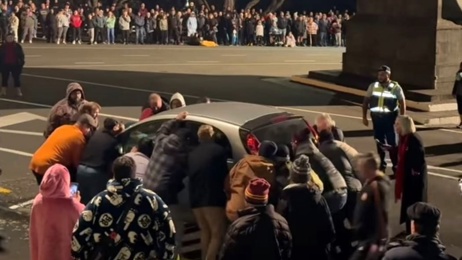In the tiny Northland township of Mangamuka, extreme weather has isolated its people and the incoming cyclone threatens to make it worse.
It was July 2020 when heavy rain saw slips wash away State Highway 1 where it crossed the Mangamuka Range, south of Kaitaia. It took a year and $14 million to open the road - and then 413 days later the rains came again and the repair work slid down the hill.
For the 500 or so people living in and around Mangamuka, it was a return to a new and seemingly persistent purgatory - they live on New Zealand’s main road but it’s now a road to nowhere.
Just outside the town is a sign which says: “SH1 closed 10km ahead”. It used to be a 25-minute drive north to Kaitaia, the closest centre.
And now, with Cyclone Gabrielle bearing down on New Zealand, the residents are bracing to be further isolated. When it rains, floods south of the town often cut off what is now Mangamuka’s only road out.
/cloudfront-ap-southeast-2.images.arcpublishing.com/nzme/CFKWCAVM2BALFPLRTX5PXG7VAU.jpeg)
State Highway 1 at Mangamuka Gorge has been closed by slips since July. It had reopened after a year-long closure in 2020-2021. Photo / David Fisher
Looking north up SH1, Shane Robinson, 52, says: “This is one big driveway from here.”
Robinson, who moved back from Australia with his family last year, is standing at the T-junction in the town where traffic is pointed south to detour to Kerikeri and then up State Highway 10.
Taking the official detour turns the journey into a two-hour slog. Locals opt for a different route to Kaitaia - west through Broadwood - which takes about 80 minutes with unexpected bumps and slumps and potholes some joke are big enough to lose a car inside.
- Cyclone Gabrielle: What you need to do now to get ready
- Cyclone Gabrielle now 'severe category 3' storm as it tracks to NZ - heavy rain watch for 71 hours
- Civil Defence may need to do welfare checks if Cyclone Gabrielle hits hard
- Live: Auckland Harbour Bridge closed; 11m high waves in Bay of Islands; state of emergency in Northland; Air NZ cancels flights
It’s a narrow and winding road, too, which makes encounters with logging trucks and milk tankers particularly nerve-wracking.
At Terran Smith’s rural retreat, he’s preparing for the cyclone by fixing black plastic across a building site and tying down anything that might catch the wind.
Smith, 65, says shopping trips to Kaitaia used to be every fortnight. “Now we just go once a month. You’ve got to keep thinking, ‘what am I going to need in the future?’. And with the cost of petrol these days, you can’t say, ‘I’ll shoot over there and get an ice cream’.”
That extra travelling, particularly on the road to Broadwood through to Kaitaia, means extra cost keeping vehicles on the road. It also means buying and storing petrol in case it is needed.
/cloudfront-ap-southeast-2.images.arcpublishing.com/nzme/YL4MN4SR7REXPF6SHFOFSGUMDQ.jpeg)
Terran Smith of Mangamuka now shops in Kaitaia once a month instead of each fortnight. Photo / David Fisher
Smith has always grown his own vegetables. When the road collapsed a second time, the need to bring food closer prompted many others to do the same. There are also those who keep livestock for food or rely on hunting, although this too has been complicated with the road closure.
The impact has been felt in many ways. The Herald on Sunday was told of those who had lost jobs in Kaitaia because the cost and travel time was too onerous.
William Barber’s partner Adeline Harris, and his son James, now leave at 4am to navigate the Broadwood Rd for a 6am work start.
“It’s costing half their pay just to get to work. Everything is way harder,” says Barber, 57. He had been working on Harris’ car this weekend “because we can’t afford to get it to a garage”.
To live here, particularly with the imposed isolation, “you need to have a bit of a clue”, he reckons.
“Last year, when they opened the gorge, they shouldn’t have put the trucks through there. You keep putting heavy vehicles on the road and it won’t handle it.”
/cloudfront-ap-southeast-2.images.arcpublishing.com/nzme/NAVAY36FFZHBNNIMJ2FWKD35QE.jpeg)
The sign marks the beginning of the "big driveway" - a section of SH1 used only by locals of a tiny Northland town. Photo / David Fisher
If there is a bright side, it’s the lack of traffic noise. Along that 10km stretch of SH1, right up to the gate barring access further north, there are few vehicles on the road and the bird song is constant and loud.
Jack Lemon, 56, watches helicopters fly over the ruined road and sees cars with specialists driving to inspect the works.
“Waka Kotahi must be spending a lot of money,” he says. But what else can they do, he asks, because the road must be fixed.
A few months back, funding of $100m was announced to allow some certainty on repairs. Even so, the hill hasn’t stopped sliding towards its base since the slip first happened. The work being done now is what is called “pre-construction and slip repairs”.
Lemon has tied down the trampoline and secured anything which might catch the wind. He asks: “What do you do with the weather? The infrastructure just can’t handle it. It’s impacting everybody.”
He’s lived in Mangamuka most of his life. “The floods are worse than they have ever been. The rain is harder - shorter but harder.
“I don’t know what’s going on with the weather but the earth is trying to tell us something.”
Take your Radio, Podcasts and Music with you









